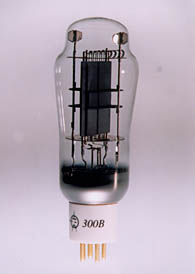|
You are reading the older HTML site Positive Feedback ISSUE 12march/april 2004
EuroAudioTeam 300B tubes
The audiophile gurus at Classic Records are expanding. Not only are they now featuring HDADs (DVD-A on one side of the disc and DVD-V on the other), but they are the exclusive U.S. importers of a new line of ultra-high-end tubes made by EuroAudioTeam (EAT for short). These tubes are precision manufactured on a separate assembly line at Tesla in the Czech Republic. I was loaned a matched pair of new 300Bs, replete with a green, hand-painted, Cartier-like wooden box, lots of measurements, all contained in a cloth tie bag and satin rope. The EATs are about 25% larger than my reference Western Electric 300Bs, making the WEs look downright wimpy by comparison. Their innards are impressively solid looking, with gold pins and silver solder. The glass looks a bit thick, but it is still completely transparent, and the shape is very 21st Century, with tall, angular sides and rounded tops. They do not look like they used to reside in a Philco radio. Just handling them gives the impression that they will kick butt. I assembled a SET system consisting of an Audio Electronic Supply AE-1 stereo amp tricked out by Dennis Had, a Marantz 17 Tuner, a JVC DVD/CD LTR Special Edition Player, and an Adcom 155 preamp with no active stages. Everything was wired with Kimber and Soundstring cable. The speakers were Paradigm Studio 20 v2s, bi-wired with Esoteric Audio Cable. This system has the purity to identify the smallest coloration and the dynamics of nearly full-range speakers with real world efficiency. I burned the EATs in with signal for more than seventy-five hours before reviewing, which according to the distributor was more than enough time. The WEs were already broken in. The AE-1 amp puts out eight watts per channel, but sounds like triple that in actual listening, so clipping was not an issue—quality of reproduction was the key. My first listening was with the tuner, and the EATs sounded absolutely gorgeous, with low distorion and lots of definition and air on the best of LA’s classical FM choices. There was plenty of power, drive, and texture. The EATs were very slightly crisper than the WEs, but otherwise identical. FM was just not detailed enough to identify much difference. Both sets of tubes were terrific, with lots of winning 3-D quality. I then switched to CDs, and Diana Krall’s Love Scenes (Impulse233), took its turn in the JVC after a spin in the Bedini. With the EATs, the CD sounded lively and textured. The sound was very focused, and Krall’s voice was spot on. The piano had lots of texture and tonality. The bass was deep, tight, neutral, and dynamic. The WEs sounded just about the same—a touch warmer, but not tan-colored at all. I’d hate to have to pick a winner. The EATs did sound a tad more powerful, and slightly, and I mean slightly more snappy and neutral. Next up was Alan Hovhaness’ Mysterious Mountain(Telarc 60604). The sustained strings, the basses in particular, allowed me to hear subtle differences. The WEs were detailed, liquid, realistic. The EATs were just as detailed, with added punch and less overload/smear on big crescendos. They were less liquid, more neutral, and more dramatic, with softer softs and louder louds. They were a bit more exciting and powerful, and did a great job pulling me into the music. The EATs also sounded like they had lower distortion. They did not sound aggressive or crisp, just neutral, smooth, dynamic, and supremely detailed. Though the WEs were more liquid, which I thought was good, the EATs did a better job driving the Paradigms while remaining enjoyable at all volume levels. Rachel Podger’s La Stravaganza (Channel Classics 19503) is renowned for natural sound and a great performance. First up were the EATs. The smoothness and drive of these tubes was just plain exciting. They had no colorations I could point to, no lumps or bumps at any frequency, just lots of extension, power, texture, and precise imaging. The glass window between myself and the performance was crystal clear. The EATs were slightly vivid sounding on this recording as well, like 300Bs with KT88 cousins in the family. This seems to me to be the sound of a truly modern, newly-designed 300B—not your grandfather’s tube, not a copy of a copy, but something really new. The WEs were again more liquid and less powerful, with a more traditional, highly textured sound that was as lovely as a bouquet of expensive roses. The WEs were not the losers here, but they were a bit out-gunned. The EuroAudioTeam did a mighty fine job designing and executing these superb tubes, and Michael Hobson is to be thanked for bringing them to American audiophiles. The EAT folks also make KT88s, 52Bs, 45s, 2A3s, and a few more variants. I am curious about the KT88s, since the 300Bs were so winning. These tubes appear to be designed from the ground up. They are better at dynamics and sonic neutrality than vintage (or reissue vintage) tubes while remaining ultra smooth and state-of-the-art detailed. This is 21st Century tube sound for the world’s best phono and SACD reproduction. You cannot go wrong running EAT 300Bs in any application ($440 each). I could EAT this slice of audio heaven for breakfast, lunch, and dinner! Robert H. Levi PS - I bought these tubes to use as my reference.
TheMusic.com
|

